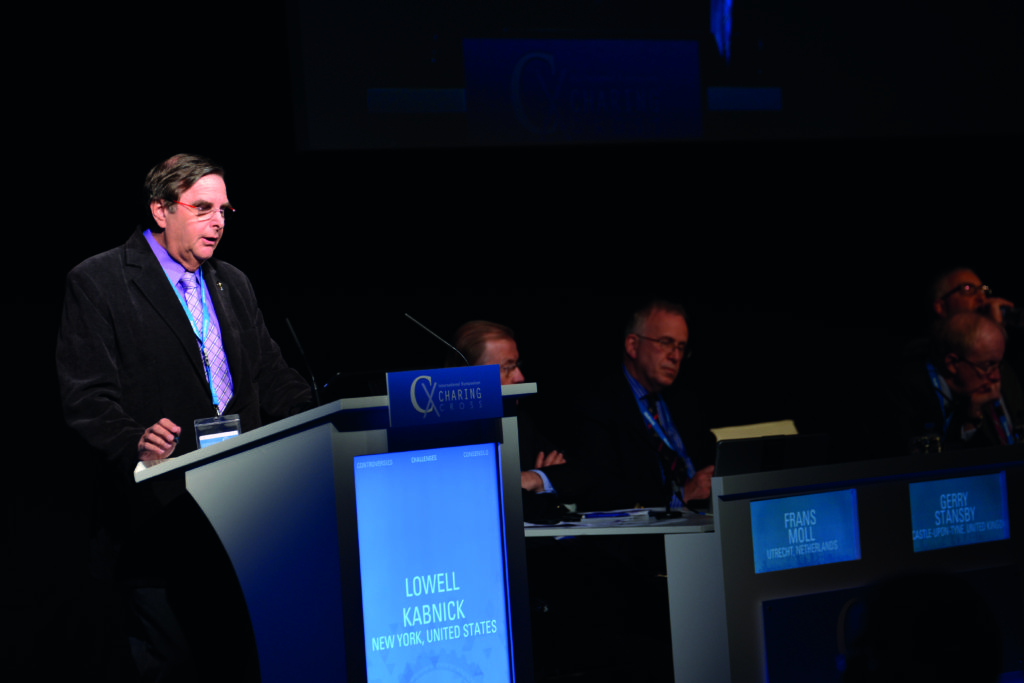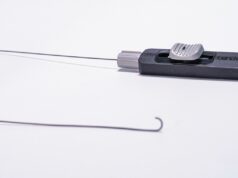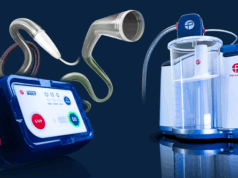
Two 2016 Charing Cross Symposium (CX 2016; 26–29 April, London, UK) presentations in the Venous Challenges Main Programme session have demonstrated the value of dedicated venous stents, with interim results from two studies in patients with symptomatic iliofemoral venous outflow obstruction showing symptom improvement 12-months post-stent placement.
Feasibility data from the VIRTUS study were presented for the first time at Charing Cross by Lowell Kabnick (NewYork, USA). Kabnick maintained that based on the feasibility data, dedicated venous stents are necessary as the early results are very promising, with 12-month primary patency >90%. He added that safety and efficacy results appear to be superior to published literature from the VIRTUS and VIVO-EU trials.
According to Kabnick, the Vici Venous stent (Veniti) has a high crush resistance, a closed cell design, end-to-end shape and strength 9F delivery system. The Vici Venous stent is available in lengths 60, 90 and 120mm and diameters 12, 14 and 16mm.
The objective of the trial is to assess the safety and effectiveness of the Vici Venous stent in achieving patency of target venous lesion through 12 months post-placement. Safety is determined by major adverse events at 30 days and effectiveness by primary patency at 12 months. The prospective, multicentre, single arm non-randomised trial is being conducted at up to 45 sites worldwide. The trial will enrol 200 patients with clinically significant chronic non-malignant obstruction of the iliofemoral venous segment.
Yesterday, Kabnick presented 12-month post-placement data from the feasibility cohort of the first 30 patients treated with the device. He reported that lesion stenosis is calculated by venogram as mandated by the US Food and Drug Administration (FDA) and ≥50% stenosis is required for patient inclusion.
According to Kabnick, the feasibility data show 85.2% lesion stenosis pre-procedure as determined by IVUS, and 1.8% lesion stenosis post procedure as determined by IVUS. Additionally, there was only one patient with >50% stenosis at 12 months post-placement.
In terms of the primary safety endpoint at 30-days post-placement, Kabnick reported that there were no composite major adverse events.
As it relates to published trials, he explained that the VIRTUS feasibility cohort seems to be better or equal to published effectiveness and safety of iliofemoral venous stenting.
Looking at 12-month status post-placement, Kabnick added that 85% of the population showed symptomatic improvement (VCSS ≥2) and 59% had substantial symptomatic improvement (VCSS ≥4). Further, he stated that univariate analysis of predictors of substantial symptomatic improvement show that “there was no significant difference, however, minimum lumen diameter by Venogram (substantial improvement: 2.4±2.2; no substantial improvement: 5.5±4.5; p=0.075) may approach statistical significance with a further look”.
Kabnick concluded stating, “In terms of the feasibility trial, dedicated venous stents are necessary and the early results are very promising. Twelve-month primary patency rates in the feasibility cohort are >90%.”
Later in the session, Gerard O’Sullivan (Galway, Ireland) presented interim results from a European study of the Zilver Vena Venous Stent (VIVO-EU). He reported that stent placement resulted in a greater than 100% luminal diameter improvement at procedure.
VIVO-EU, a prospective, non-randomised, multicentre study, is intended to evaluate the Zilver Vena stent (Cook Medical) in the treatment of symptomatic iliofemoral venous outflow obstruction. Patients participating in the study are followed after their procedure to monitor complication rates and improvement of symptoms.
The Zilver Vena Venous Stent, CE marked in 2010, is a self-expanding nitinol stent available in 14 and 16mm diameters and 60, 100, and 140mm lengths. The stent is intended for use in the iliofemoral veins for the treatment of symptomatic venous outflow obstruction.
The study has reached full enrolment, with final follow-up anticipated in summer 2016. Thirty-five patients with symptomatic iliofemoral outflow obstruction (ie. CEAP “C” ≥3 or VCSS pain score ≥2) were enrolled into the study. Consistent with this patient population, the patients in this study had predominantly left-sided lesions (94%).
In terms of major adverse events, O’Sullivan reported a clinically-driven reintervention for occlusion at 155 days post-procedure and a symptomatic pulmonary embolism one day post-procedure, categorised as possibly related to the study procedure and managed by a change in medication. No additional clinical sequelae were reported.
He explained that at procedure, Zilver Vena stent placement resulted in a more than two-fold improvement in the vessel minimum lumen diameter. Available clinical, data, O’Sullivan said, “suggest that stent placement corresponds to improved clinical symptoms as measured by VCSS, VDS, CIVIQ, and CEAP ‘C’, suggesting that the Zilver Venous stent is beneficial to patients”.













